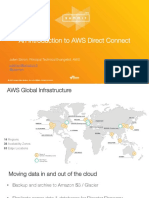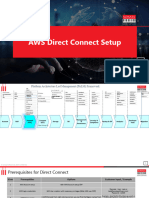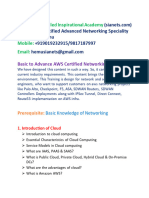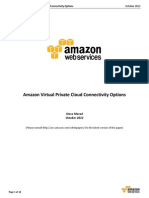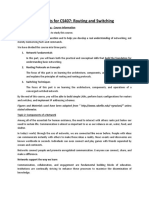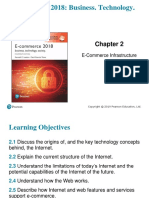0% found this document useful (0 votes)
44 views8 pagesUnderstanding Direct Connect
The document provides an overview of AWS Direct Connect, a service that allows customers to establish a dedicated network connection from their network to AWS. Some key points covered include:
- Direct Connect allows customers to bypass the internet and create a dedicated private connection between their own data center and an AWS Virtual Private Cloud (VPC). This reduces latency and inconsistent network performance compared to internet connections.
- Benefits of Direct Connect include consistent network performance, reduced bandwidth costs compared to internet service providers, and private connectivity to the VPC without security risks of internet traffic.
- The Direct Connect architecture involves connecting the customer's data center to an AWS Direct Connect provider, who maintains a dedicated fiber optic line to AWS. This creates a
Uploaded by
shubh240184Copyright
© © All Rights Reserved
We take content rights seriously. If you suspect this is your content, claim it here.
Available Formats
Download as TXT, PDF, TXT or read online on Scribd
0% found this document useful (0 votes)
44 views8 pagesUnderstanding Direct Connect
The document provides an overview of AWS Direct Connect, a service that allows customers to establish a dedicated network connection from their network to AWS. Some key points covered include:
- Direct Connect allows customers to bypass the internet and create a dedicated private connection between their own data center and an AWS Virtual Private Cloud (VPC). This reduces latency and inconsistent network performance compared to internet connections.
- Benefits of Direct Connect include consistent network performance, reduced bandwidth costs compared to internet service providers, and private connectivity to the VPC without security risks of internet traffic.
- The Direct Connect architecture involves connecting the customer's data center to an AWS Direct Connect provider, who maintains a dedicated fiber optic line to AWS. This creates a
Uploaded by
shubh240184Copyright
© © All Rights Reserved
We take content rights seriously. If you suspect this is your content, claim it here.
Available Formats
Download as TXT, PDF, TXT or read online on Scribd
/ 8





